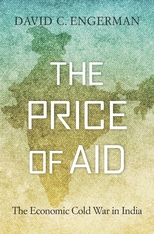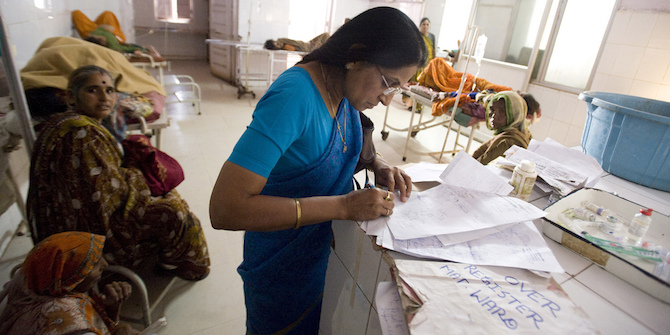In The Price of Aid: The Economic Cold War in India, David C. Engerman chronicles in meticulous detail the pulls and pressures India’s postcolonial state had to deal with in attempting to build a modern, prosperous and independent nation against the backdrop of an international Cold War. Did India’s policy of “non-alignment” offer its domestic interlocutors considerable leverage vis-à-vis the Cold War superpowers in negotiating advantageous aid packages, or did it hamper the country’s ability to pursue an autonomous path of economic development? Raghunath Nageswaran finds a book that offers a rich and erudite account of India’s tryst with economic aid and its momentous consequences.
The Price of Aid: The Economic Cold War in India. David C. Engerman. Harvard University Press. 2018
It is widely believed that India was peripheral to the Cold War calculations of the superpowers, the United States and the Soviet Union, because of its much-celebrated neutral positioning on the international stage, officially known as the policy of “non-alignment”. This foreign policy stance was well in sync with the pursuit of the goal of self-reliance in economic matters, as allegiance to one of the superpowers would have translated into a loss of sovereignty and lead to dictation of economic policy choices by them. India’s decision to remain equidistant from the two superpowers that were vying to win India over to their respective sides appeared to be strategically prudent.
 David Engerman challenges this conventional wisdom by presenting a coherent body of arguments that emerge from both extensive and intensive archival research on Cold War dynamics in which India was in the eye of the storm. The Price of Aid: The Economic Cold War in India examines whether India chose to take the path of dependence to attain the goal of self-reliance and ended up paying a huge price as a result. The book under review helps us understand the international context in which economic aid was invented and how India became the laboratory for the evolution of aid practices that shaped the course of the engagement of the superpowers with the wider Third World.
David Engerman challenges this conventional wisdom by presenting a coherent body of arguments that emerge from both extensive and intensive archival research on Cold War dynamics in which India was in the eye of the storm. The Price of Aid: The Economic Cold War in India examines whether India chose to take the path of dependence to attain the goal of self-reliance and ended up paying a huge price as a result. The book under review helps us understand the international context in which economic aid was invented and how India became the laboratory for the evolution of aid practices that shaped the course of the engagement of the superpowers with the wider Third World.
Post World War II, while former imperialist powers were engaged in reconstruction of their own economies (thanks to the Marshall Plan) and in erecting welfare states to counter the Red Scare of communism, they also had a keen eye on the geopolitical imperatives of shaping and influencing Third World policies. The strategic vision of the “free world” led by the United States to win over non-aligned countries was centered on an economic pivot that set off cut-throat aid competition between them and the Communist Bloc spearheaded by the Soviet Union.
Economic cold war was giving birth to the globalization of ideological competition between the Cold War superpowers and the idea of “development” that came in its train chose the nation-state as the instrumentality for mediating the competition. The nation-state had to develop the capacity to navigate the heady winds blowing from both directions, while ensuring that its sovereignty remained intact.
Following the wave of decolonisation, former colonies that attempted to embark upon economic development were seriously resource-constrained. The situation warranted dependence on erstwhile colonisers and Cold War superpowers for economic assistance, which eventually took the form of development aid. Such development assistance was directed at the core economic challenges confronting the postcolonial world. The postcolonial governments had to negotiate their way through the numerous “conditionalities” that came attached to economic aid. Engerman’s succinct description of these dynamics sets the tone for the rest of the narrative: “In short, officials in the superpowers used development aid as a Cold War weapon while constituencies in recipient nations used the Cold War as a development weapon” (pp. 9).
Note the word ‘constituencies’ in the statement. It conveys the message that there was no one monolithic view or unifying sentiment among key institutions and individuals in recipient nations towards the Cold War rivalry. While ideology did matter to some constituencies, political instrumentalism of attracting economic aid trumped ideology for the rest. The Indian case is the paradigmatic example of the fragmented nature of the nation-state in responding to the incentives and imperatives generated by development assistance. The interplay of individuals, institutions and ideology produced mixed results even as India made conscious efforts to keep in abeyance the moral obligations imposed by development aid.
Until the mid-sixties, even though Jawaharlal Nehru was the chief decision-maker, the cases in favour of economic aid were presented to him by ministers, bureaucrats and technocrats, some leaning towards the US and others with an affinity for the Soviet Union. These were ambitious individuals fiercely competing among themselves to further their respective visions of India’s economic future and its place in the world. In pursuit of this end, they built international networks of support, thereby creating pro-India camps in the US, Soviet Union, Britain, Germany and Japan among others. Engerman calls “this dynamic – the competition for external aid and its entanglement with domestic politics – development politics” (pp.3).
An illustration would offer a glimpse into the broad contours of development politics. The acute foreign exchange crunch that hampered the implementation of the Second Five Year Plan was perceived as a golden opportunity by the pro-US camp in India to tilt foreign policy in a direction that would convince the US to ramp up economic aid to India, especially in the form of “free money”. The intention was to get economic assistance not tied to any particular project, which stood sharply in contrast to the nature of aid arrangements India had with the Soviet Union, outflanking the pro-Soviet camp in the process.
Initially, Americans in the National Security Council and other agencies were not particularly keen on sponsoring India’s development efforts but the establishment of People’s Republic of China forced a fundamental shift in the geopolitical priorities of the US. The Americans began mustering their energy to think up strategies to keep India out of the Communist camp because they wanted to install India as the bulwark against the “domino effect” in South Asia, thanks to its early embrace of democracy.
The U.S. wanted India to take a path of economic development that was agriculture-centric and driven by private investment on the industrialisation front. That way, aid could take the form of non-material technical aid, greater trade engagement and private investment. The Soviet Union imagined a trajectory that would put India on a firm industrial growth path led by centralised planning and public sector investments. Its economic support was designed in a manner that would favour large-scale heavy industries, enabling India to build capacity domestically.
But over a period of time, the nature of Soviet economic support underwent interesting changes – from machinery and equipment for industrial projects, through rupee-denominated trade arrangements and finally to military support. The Sino-Indian conflict in 1962 and India’s involvement in the 1971 Bangladesh Liberation War caused decisive shifts in how the two superpowers viewed India’s loyalty to their respective geopolitical visions and it dramatically transformed aid relations.
According to Engerman, the most consequential adverse impact of aid was the distortion of India’s political economy and the institutional decline that precipitated it. Sure, economic aid put national sovereignty under severe stress and increasing reliance on such assistance made it easier for the donor countries to dictate the direction of economic policy and press for “economic reforms”. That said, the institutional reasons for India’s problematic political economy beginning in the late 1960s have deep structural roots in the flawed nature of India’s developmental state. With each ministry trying to undercut competing ministries and the ministries collectively undermining the significance of the Planning Commission in economic matters, the resultant institutional impasse had corrosive effects on India’s political economy.
Elite networks comprising individual ministers, influential technocrats, high-profile bureaucrats and diplomats had considerable impact on the nature of economic policy decisions made, but going by the narrative presented in the book, one wonders whether there was any semblance of democratic accountability to the public. It is important to note this because the ramifications of those policy decisions were widespread and continue to be felt even today. For example, the Green Revolution was a product of both conscious policy choices and historical contingencies against the backdrop of Cold War era realpolitik. It shifted the coordinates of the debate regarding agrarian transformation in India away from equitable land reforms. It had far-reaching consequences for India’s agriculture and polity but it was essentially a technocratic fix to a socio-political predicament.
The Price of Aid is descriptively robust and analytically engaging. It is a work of scholarship that has immense narrative-changing potential. A short review certainly cannot do justice to the breadth and depth of the arguments Engerman has presented in the book. It has to be read to be appreciated for enriching our understanding of postcolonial India’s economic history as it unfolded in an ideologically-charged global context.
This article gives the views of the author, and not the position of the South Asia @ LSE blog, nor of the London School of Economics. Please read our comments policy before posting. Photo Credit: Ishant Mishra, Unsplash,
Raghunath Nageswaran has an M.A. in Economics from Madras Christian College, Chennai (India). His principal area of research interest is the political economy and economic history of post-independence India. He is a freelance writer and can be contacted at raghind@gmail.com.






